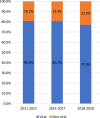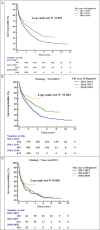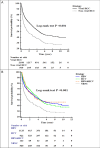Increased prevalence but decreased survival of nonviral hepatocellular carcinoma compared to viral hepatocellular carcinoma in recent ten years
- PMID: 38643245
- PMCID: PMC11032374
- DOI: 10.1038/s41598-024-59668-2
Increased prevalence but decreased survival of nonviral hepatocellular carcinoma compared to viral hepatocellular carcinoma in recent ten years
Abstract
Due to the comprehensive hepatitis B virus vaccination program in Taiwan since 1986, the development of antiviral therapy for chronic hepatitis B and chronic hepatitis C infection and covered by National health insurance. Besides, the increased prevalence of nonalcoholic fatty liver disease (NAFLD) and currently, approved therapy for NAFLD remain developing. The etiology of liver-related diseases such as cirrhosis and hepatocellular carcinoma required reinterpretation. This study aimed to analyze the incidence and outcome of hepatocellular carcinoma (HCC) due to viral (hepatitis B and hepatitis C) infection compared to that of nonviral etiology. We retrospectively analyzed patients with HCC from January 2011 to December 2020 from the cancer registry at our institution. Viral-related hepatitis was defined as hepatitis B surface antigen positivity or anti-hepatitis C virus (HCV) antibody positivity. A total of 2748 patients with HCC were enrolled, of which 2188 had viral-related HCC and 560 had nonviral-related HCC. In viral HCC group, the median age at diagnosis was significantly lower (65 years versus 71 years, p < 0.001), and the prevalence of early-stage HCC, including stage 0 and stage A Barcelona Clinic Liver Cancer, was significantly higher (52.9% versus 33.6%, p < 0.001). In nonviral HCC group, alcohol use was more common (39.9% versus 30.1%, p < 0.001), the prevalence of type 2 diabetes mellitus (T2DM) was higher (54.5% versus 35.1%, p < 0.001), and obesity was common (25.0% versus 20.5%, p = 0.026). The prevalence of nonviral HCC increased significantly from 19.2 to 19.3% and 23.0% in the last 10 years (p = 0.046). Overall survival was better in the viral HCC group (5.95 years versus 4.00 years, p < 0.001). In the early stage of HCC, overall survival was still better in the viral HCC group (p < 0.001). The prevalence of nonviral HCC has significantly increased in the last ten years. The overall survival was significantly lower in the nonviral HCC, perhaps because the rate of early HCC detection is lower in nonviral HCC and anti-viral therapy. To detect nonviral HCC early, we should evaluate liver fibrosis in high-risk groups (including people with obesity or T2DM with NAFLD/NASH and alcoholic liver disease) and regular follow-up for those with liver fibrosis, regardless of cirrhosis.
Keywords: Alcoholic liver disease; Non alcoholic fatty liver disease; Non-viral hepatocellular carcinoma; Type 2 diabetes mellitus; Viral hepatocellular carcinoma.
© 2024. The Author(s).
Conflict of interest statement
The authors declare no competing interests.
Figures




Similar articles
-
Differentiation of clinical patterns and survival outcomes of hepatocellular carcinoma on hepatitis B and nonalcoholic fatty liver disease.J Chin Med Assoc. 2021 Jun 1;84(6):606-613. doi: 10.1097/JCMA.0000000000000530. J Chin Med Assoc. 2021. PMID: 33871391
-
Comparing clinical presentations, treatments and outcomes of hepatocellular carcinoma due to hepatitis C and non-alcoholic fatty liver disease.QJM. 2017 Feb 1;110(2):73-81. doi: 10.1093/qjmed/hcw151. QJM. 2017. PMID: 27634970 Free PMC article.
-
Early Fibrosis but Late Tumor Stage and Worse Outcomes in Hepatocellular Carcinoma Patients Without Hepatitis B or Hepatitis C.Dig Dis Sci. 2020 Jul;65(7):2120-2129. doi: 10.1007/s10620-019-05938-3. Epub 2019 Nov 13. Dig Dis Sci. 2020. PMID: 31722058
-
Clinical features of hepatocellular carcinoma associated with nonalcoholic fatty liver disease: a review of human studies.Clin J Gastroenterol. 2015 Feb;8(1):1-9. doi: 10.1007/s12328-014-0548-5. Epub 2015 Jan 10. Clin J Gastroenterol. 2015. PMID: 25575848 Review.
-
Screening and interventions to prevent nonalcoholic fatty liver disease/nonalcoholic steatohepatitis-associated hepatocellular carcinoma.World J Gastroenterol. 2023 Jan 14;29(2):286-309. doi: 10.3748/wjg.v29.i2.286. World J Gastroenterol. 2023. PMID: 36687124 Free PMC article. Review.
Cited by
-
Demographics and Immunotherapy Efficacy for Advanced Hepatocellular Carcinoma: A Systematic Review and Meta-Analysis of Phase III Clinical Trials.Liver Cancer. 2024 Nov 13;14(3):302-310. doi: 10.1159/000542576. eCollection 2025 Jun. Liver Cancer. 2024. PMID: 40547956 Free PMC article. Review.
-
Trends and visualization analysis of research on MASLD-Related hepatocellular carcinoma: a bibliometric analysis.Discov Oncol. 2025 Jun 11;16(1):1057. doi: 10.1007/s12672-025-02858-9. Discov Oncol. 2025. PMID: 40500549 Free PMC article.
References
MeSH terms
Grants and funding
LinkOut - more resources
Full Text Sources
Medical

